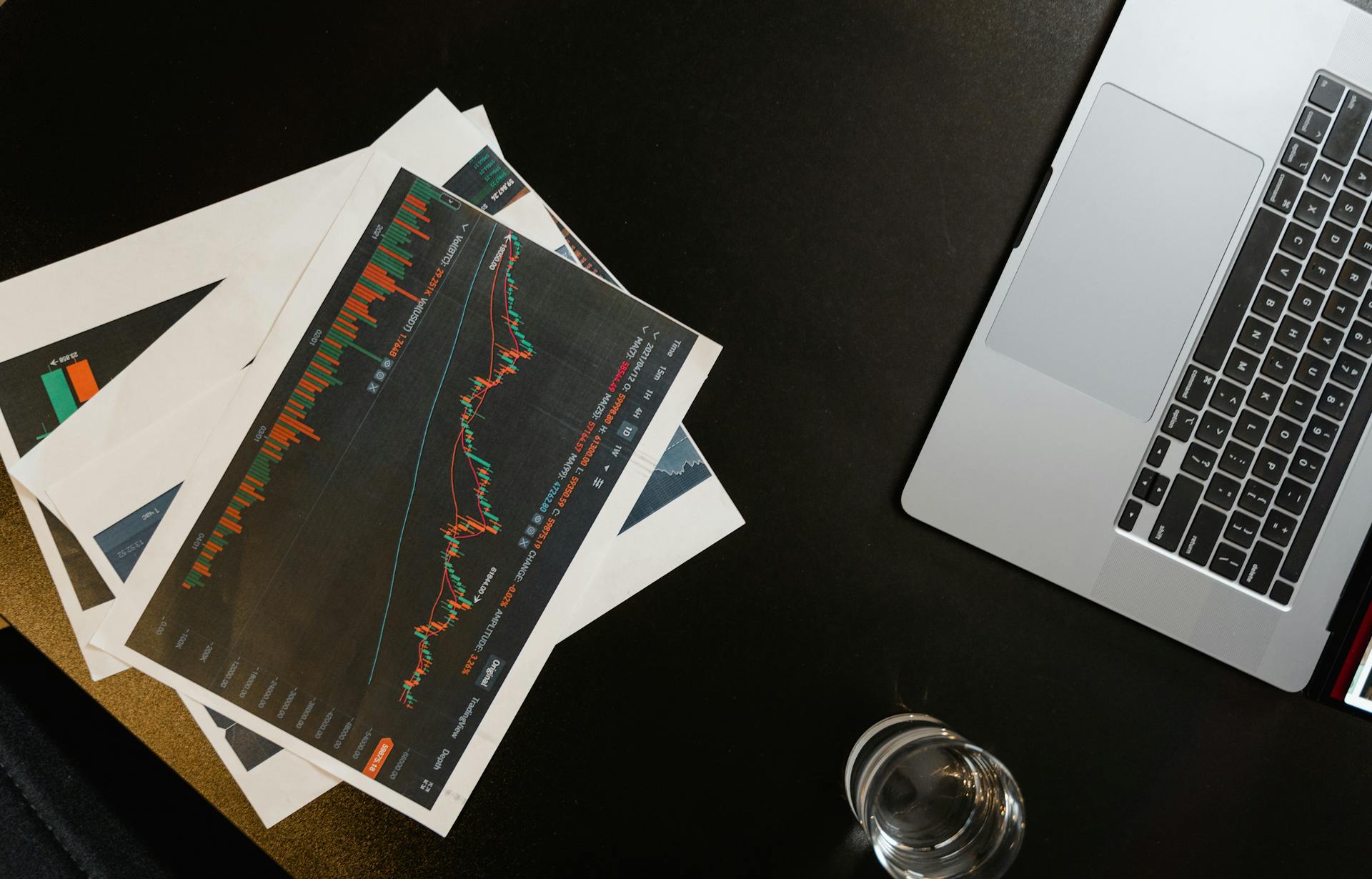
ESG ratings have become a crucial tool for investors and companies alike, offering a snapshot of a company's environmental, social, and governance performance.
By considering ESG ratings, investors can make more informed decisions about their investments, reducing the risk of financial losses and promoting sustainable growth.
Research has shown that companies with high ESG ratings tend to outperform those with low ratings, with a study by MSCI finding that ESG leaders outperformed non-leaders by 4.8% per year from 2012 to 2019.
ESG ratings can also help companies identify areas for improvement, leading to more sustainable business practices and reduced operational risks.
Investors can use ESG ratings to screen for companies that align with their values and investment goals, making it easier to create a portfolio that reflects their values.
How It Works
MSCI ESG Ratings use a model that identifies the ESG risks and opportunities most material to a specific industry. This model has been refined over 13 years of live track history.
The model looks at the E, S, and G Key Issues that are most relevant to an industry, which are examined and refined over time.
These Key Issues can vary by industry, but the model helps to identify the most material ones.
The MSCI ESG Ratings model has been able to identify the Key Issues that are most relevant to a GICS sub-industry or sector.
You can view the Key Issues framework on MSCI's website, along with their ESG methodologies and information on what their ESG Ratings are and are not.
For your interest: Msci Esg Fund Ratings
ESG Ratings and Scores
ESG Ratings and Scores are used to measure a company's management of financially relevant ESG risks and opportunities. MSCI ESG Ratings, for example, use a rules-based methodology to identify industry leaders and laggards according to their exposure to ESG risks and how well they manage those risks relative to peers.
Companies with strong MSCI ESG Ratings profiles may be better positioned for future challenges and experience fewer instances of bribery, corruption, and fraud. This is because MSCI ESG Ratings range from leader (AAA, AA) to laggard (B, CCC), with a score calculated as the sum of unmanaged risk for their Material ESG Issues.
A company's final ESG Risk Rating score is calculated as the sum of unmanaged risk for their Material ESG Issues, with unmanaged risks of Material ESG Issues calculated as risk exposure minus managed risk. Companies receive a final numeric score and are then assigned one of five ESG risk categories: negligible, low, medium, high, and severe.
Here is an example of the MSCI ESG Letter Grade Rating System:
What Is an Index?
An index is a collection of stocks or bonds that represent a particular market or sector. MSCI ESG Ratings use a rules-based methodology to identify industry leaders and laggards according to their exposure to ESG risks and opportunities.
MSCI ESG Ratings measure a company's management of financially relevant ESG risks and opportunities. This helps investors make informed decisions about their investments.
The MSCI ESG Ratings range from leader (AAA, AA) to laggard (B, CCC).
Hierarchy of Scores
The hierarchy of ESG scores is a crucial aspect of ESG ratings and scores. Sustainalytics and MSCI both use a scoring structure that assesses a company's exposure to ESG risks and opportunities.
Sustainalytics uses a proprietary industry classification system to categorize companies across 138 sub-industries. They assess companies based on risk exposure levels and associated risk management strategies. Companies are grouped into one of five risk categories: negligible, low, medium, high, and severe.
MSCI's ESG Ratings system is based on a weighted average of Pillar scores, which are calculated from Key Issue scores. The Key Issue scores are aggregated from raw public data and are then adjusted compared to industry peers.
The hierarchy of ESG scores varies between providers, but generally, the scores are categorized into different levels of risk or performance. For example, MSCI's ESG Rating system assigns a final industry-adjusted company score, which is then used to determine an ESG letter rating. The ESG letter rating ranges from AAA (leader) to CCC (laggard).
Here is a breakdown of MSCI's ESG letter rating system:
This hierarchy of scores provides a clear and transparent way to understand a company's ESG performance and risk exposure. By understanding the different levels of risk and performance, investors and stakeholders can make informed decisions about their investments and business relationships.
Sustainalytics vs. S&P Global
Sustainalytics and S&P Global are two prominent organizations that provide ESG rating assurance to companies. They are recognized for their commitment to ESG and sustainability-related issues.
Sustainalytics is one of the organizations that companies turn to for ESG rating assurance. Investors are increasingly integrating ESG considerations into their decision-making process.
Companies can demonstrate their commitment to ESG and sustainability-related issues by obtaining ESG rating assurance from organizations like Sustainalytics. This is particularly important for companies that face growing investor and stakeholder expectations.
Investors are progressively integrating ESG considerations into their decision-making process. A growing number of managed funds require specific mandates on strong ESG performance before committing to investments.
Expand your knowledge: Sustainalytics Esg Ratings
Transparency and Reporting
Over 64% of investors agree that ordinary investors should put pressure on companies to be more transparent.
Companies like US-based producers of paper products are already disclosing their ESG metrics and sources used to determine their MSCI ESG Rating.
Researching industry leaders' ESG reports can help determine what data they're disclosing and which frameworks they're using.
You can download peers' ESG reports to get a better understanding of their ESG reporting practices.
What Is Reporting?
Reporting is a crucial aspect of transparency in business. More than half of investors agree that companies should be more transparent.
Ordinary investors play a significant role in pushing companies to be more transparent. This is evident from the fact that 64% of investors agree with the idea of putting pressure on companies to be more transparent.
Clear and accurate reporting is essential for investors to make informed decisions.
Transparency Tools Content - Part 1
Transparency is key to making informed decisions, and that's especially true when it comes to ESG (Environmental, Social, and Governance) reporting. Over 2,900 companies are now covered in our ESG Transparency Tools content.
These companies' ESG data is available for exploration, including their Implied Temperature Rise, Decarbonization Targets, MSCI ESG Rating, and Key ESG Issues. You can even explore E, S & G Key Issues by GICS sub-industry or sector and see how they contribute to companies' ESG Ratings.
Our data metrics and sources are transparent, and you can see exactly how we determine the MSCI ESG Rating of a company. For example, if you're interested in a US-based producer of paper products, you can explore the data metrics and sources used to determine their MSCI ESG Rating.
Here are some key ESG metrics and sources used in our research:
- Implied Temperature Rise
- Decarbonization Targets
- MSCI ESG Rating
- Key ESG Issues
These metrics and sources help us provide a comprehensive view of a company's ESG performance. By exploring this data, you can gain a deeper understanding of a company's strengths and weaknesses when it comes to ESG.
For more insights, see: How to Find a Company's Esg Score
How to Start Reporting
To start reporting, you need to identify the type of report you want to create. According to the article, there are two main types of reports: financial and non-financial.
Financial reports, such as annual reports, are required by law for publicly traded companies. They provide a snapshot of a company's financial performance over a specific period.
Readers also liked: Symetra Financial Ratings
For non-financial reports, you can use the Global Reporting Initiative (GRI) framework, which provides a set of guidelines for reporting on sustainability and social responsibility. The GRI framework includes 64 indicators across 34 topics.
Start by defining the purpose and scope of your report, including the stakeholders you want to engage and the information you want to share. This will help you determine the type of report and the level of detail required.
The article also highlights the importance of transparency and accountability in reporting. According to the article, transparency is essential for building trust with stakeholders and ensuring that reports are credible and reliable.
Intriguing read: Sustainable Investing Report
Benefits and Performance
Managing for a low carbon future can improve financial performance, as a report by NYU Stern Center for Sustainable Business and Rockefeller Asset Management found. This is a significant advantage for companies looking to adopt sustainable practices.
ESG ratings help companies meet regulatory requirements and stakeholder expectations, giving them a competitive advantage in the ESG investing space. This is a key benefit for companies that want to stay ahead of the curve.
Utilizing ESG ratings and ranking services can also improve a company's reputation and mitigate risks. This is because ESG ratings provide a way to assess, benchmark, and communicate ESG performance effectively.
Our team of analysts reviews, validates, and transforms data into meaningful insights, ensuring the accuracy and reliability of our ESG ratings. This is a critical step in the ESG research process.
We use artificial intelligence and other technologies to increase the timeliness and precision of data collection and analysis. This allows us to stay up-to-date with emerging ESG issues and provide more accurate ratings.
Here are some key benefits of using ESG ratings:
- Improved financial performance
- Increased access to capital
- Competitive advantage in the ESG investing space
- Improved reputation
- Mitigated risks
By incorporating ESG ratings into their decision-making process, companies can identify and address ESG-related risks, and improve their long-term sustainability planning.
Frequently Asked Questions
What is an ESG rating?
An ESG rating measures a company's or financial instrument's sustainability performance, assessing its impact on people and the environment. It provides valuable insights into a company's exposure to sustainability risks and its overall social and environmental responsibility.
What does ESG stand for?
ESG stands for Environmental, Social, and Governance, encompassing a company's commitment to sustainability. Learn more about how ESG drives sustainable development in business.
Are ESG ratings reliable?
ESG ratings are currently unreliable due to data inadequacies and a lack of comparability. To improve their trustworthiness, collaborative efforts from various stakeholders are necessary.
What is the ESG risk measurement?
ESG risk measurement is a quantifiable assessment of a company's environmental, social, and governance risks compared to its peers. It helps investors and stakeholders understand potential risks associated with an investment or business operation.
What is the ESG risk index?
The ESG risk index, also known as ESGI, evaluates environmental, social, and governance risks in 183 countries worldwide. It assesses risks related to the environment, human rights, and health & safety on a country-by-country basis.
Sources
- https://www.msci.com/sustainable-investing/esg-ratings
- https://www.blackrock.com/us/financial-professionals/tools/esg-360-methodology
- https://www.keramida.com/blog/esg-ratings-and-rankings-which-one-is-right-for-you
- https://www.issgovernance.com/esg/ratings/corporate-rating/
- https://www.workiva.com/resources/esg-reporting-101-what-you-need-know
Featured Images: pexels.com


